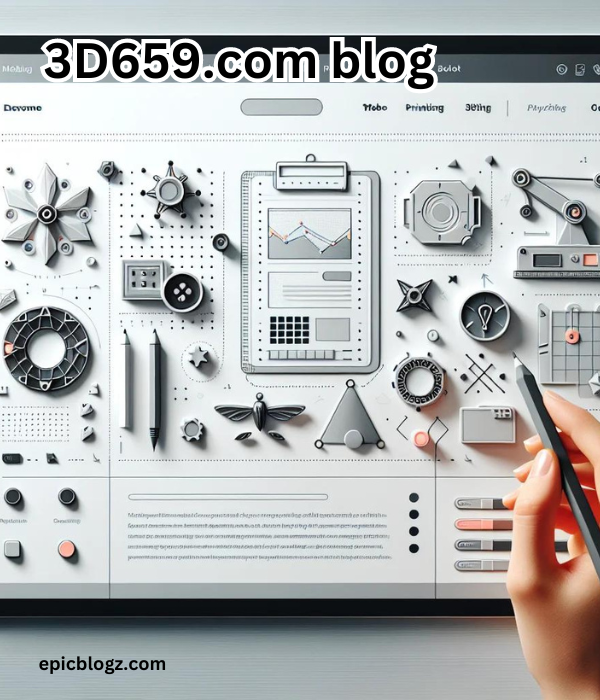Introduction
In the fast-paced world of digital design, 3D modeling and printing have become essential tools for artists, engineers, and hobbyists alike. The 3D659.com blog stands out as a comprehensive platform dedicated to exploring the vast array of 3D tools and resources available today. Whether you are a seasoned professional looking to enhance your skills or a beginner eager to dive into the world of 3D design, this blog will guide you through the essential tools, techniques, and resources that can elevate your creative projects.
The Importance of 3D Design
Why 3D Design Matters
3D design is crucial in various industries, including architecture, product design, animation, and gaming. It allows creators to visualize their ideas in a three-dimensional space, providing a more realistic representation than traditional 2D methods. This capability enhances communication between designers and clients, facilitates better decision-making, and ultimately leads to more successful projects.
Applications of 3D Design
The applications of 3D design are vast and varied. Some common uses include:
- Architectural Visualization: Architects use 3D modeling to create detailed representations of buildings and spaces before construction begins.
- Product Prototyping: Designers create prototypes of products to test functionality and aesthetics before moving into production.
- Animation and Gaming: Animators and game developers rely on 3D models to bring characters and environments to life.
- Medical Imaging: In healthcare, 3D imaging helps visualize complex structures within the human body for better diagnosis and treatment planning.
Essential 3D Tools
Software Options
Choosing the right software is crucial for effective 3D design. Here are some popular options available for various skill levels:
Blender
Blender is a powerful open-source software that offers a comprehensive suite of tools for modeling, animation, rendering, and more. Its versatility makes it suitable for beginners and professionals alike. The 3D659.com blog features tutorials and resources that help users learn Blender effectively.
Autodesk Maya
Autodesk Maya is an industry-standard software widely used in animation and visual effects. It offers advanced features for character rigging, simulation, and rendering. While it has a steeper learning curve than some other options, its capabilities make it a favorite among professionals in the film and gaming industries.
SketchUp
SketchUp is known for its user-friendly interface, making it an excellent choice for beginners. It is particularly popular in architectural design due to its intuitive tools for creating detailed models quickly. The 3D659.com blog provides tips on using SketchUp effectively for various projects.
Tinkercad
Tinkercad is an online tool designed for beginners looking to create simple 3D models. Its drag-and-drop interface makes it easy to learn the basics of modeling without overwhelming new users. Tinkercad is also an excellent platform for educators introducing students to 3D design concepts.
Hardware Requirements
To effectively work with 3D design software, having the right hardware is essential. Here are some key components to consider:
Graphics Card
A powerful graphics card (GPU) significantly enhances rendering times and overall performance in 3D applications. Look for GPUs from reputable brands such as NVIDIA or AMD that support the latest technologies.
Processor
A multi-core processor (CPU) can improve performance when working with complex models or rendering high-quality animations. Aim for at least a quad-core processor for optimal results.
RAM
Having sufficient RAM is crucial for smooth operation when working with large files or multiple applications simultaneously. A minimum of 16GB is recommended for most 3D design tasks.
Storage
Solid State Drives (SSDs) provide faster loading times compared to traditional Hard Disk Drives (HDDs). Consider using an SSD as your primary storage device for improved performance when accessing files.
Resources on the 3D659.com Blog
Tutorials and Guides
One of the standout features of the 3D659.com blog is its extensive library of tutorials and guides covering various aspects of 3D design. These resources cater to different skill levels, from beginners learning the basics to advanced users seeking specialized techniques.
Beginner Tutorials
For newcomers to the world of 3D design, beginner tutorials provide step-by-step instructions on using popular software like Blender or Tinkercad. These tutorials often include video demonstrations, making it easier for users to follow along.
Advanced Techniques
Experienced designers can benefit from advanced tutorials that delve into complex topics such as character rigging in Maya or sculpting techniques in Blender. These resources help users refine their skills and explore new creative possibilities.
Community Forums
The community aspect of the 3D659.com blog fosters collaboration among designers. The platform features forums where users can ask questions, share their work, and seek feedback from peers. Engaging with fellow designers can lead to valuable insights and inspiration while building connections within the industry.
Asset Libraries
Accessing high-quality assets can significantly enhance your projects. The 3D659.com blog offers links to various asset libraries where users can find textures, models, and materials suitable for their designs. Utilizing these resources can save time and elevate the overall quality of your work.
Staying Updated with Industry Trends
Following Industry News
Staying informed about industry trends is essential for any designer looking to remain competitive. The 3D659.com blog provides regular updates on advancements in technology, software releases, and emerging trends within the field of 3D design.
News Articles
The blog features articles discussing significant developments in the industry—such as new software releases or innovative technologies that could impact how designers work. Keeping up with these updates ensures you are aware of opportunities that could enhance your skills or streamline your workflow.
Networking Opportunities
Networking plays a vital role in career advancement within the creative industry. The 3D659.com blog often highlights events such as conferences, webinars, or workshops where designers can connect with industry professionals and expand their knowledge base.
Tips for Effective 3D Design
Plan Your Projects
Before diving into a new project, take time to plan your approach thoroughly. Outline your goals, gather reference materials, and create sketches if necessary. Planning helps streamline your workflow and ensures you stay focused on achieving your desired outcome.
Experiment with Different Styles
Don’t be afraid to experiment with various styles or techniques during your creative process! Trying out new approaches can lead you down unexpected paths that may inspire innovative ideas or solutions you hadn’t considered before.
Seek Feedback from Peers
Sharing your work with others allows you to gain valuable feedback on areas where improvement may be needed or aspects that resonate well with viewers. Constructive criticism helps refine your skills while fostering growth as an artist.
Conclusion
The 3D659.com blog serves as an invaluable resource for anyone interested in exploring the world of 3D tools and resources. From comprehensive tutorials covering essential software options to community forums fostering collaboration among designers—this platform equips users with everything they need to succeed in their creative endeavors. By staying informed about industry trends while utilizing available assets effectively—designers can elevate their projects beyond expectations!
Whether you’re just starting out or looking to advance your skills further—let the 3D659.com blog be your guide through this exciting journey into the realm of three-dimensional creativity! Embrace experimentation while seeking connections within this vibrant community; together we’ll shape tomorrow’s innovations today!
ALSO READ: Vacumetros: Which One is Right for You?
FAQs
The 3D659.com blog focuses on exploring 3D tools and resources, providing valuable information on software options, hardware requirements, tutorials, and industry trends in the field of 3D design.
The blog discusses various software options for 3D design, including Blender, Autodesk Maya, SketchUp, and Tinkercad. Each software is reviewed for its features, usability, and suitability for different skill levels.
Yes! The 3D659.com blog offers a range of beginner tutorials and guides that provide step-by-step instructions on using popular 3D design software, making it accessible for newcomers to the field.
The blog features community forums where users can ask questions, share their work, and provide feedback. This interactive environment fosters collaboration and connection among designers.
Absolutely! The 3D659.com blog regularly publishes articles that cover advancements in technology, new software releases, and emerging trends in 3D design to keep readers informed and competitive in the industry.







